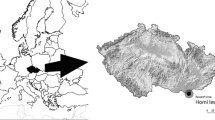Abstract
Yield estimates from single stands in short-rotation willow (Salix spp.) have been reported to differ substantially, depending on the estimation methods used. The magnitude of differences in estimates resulting from different methods may vary among clones on the same site. This indicates that some assumptions, implicitly made by using a certain method, cannot be generalised for all clones. To assess why estimates of different methods may differ and why the magnitude of the differences may be clone-specific for a given site, a number of assumptions underlying destructive and non-destructive protocols for the estimation of aboveground willow biomass were tested. Apart from general problems in satisfying the demands of representative sampling and meeting the assumptions that underlie the proper use of statistical models, it was found that basic assumptions with regard to the physical structure and phenology of willow may lead to the observed differences. For a given clone, the moisture content of willow shoots may vary over time and may be dependent on shoot size. For a given shoot, the moisture content of basal, apical and central stem parts may differ, with the magnitude of differences being dependent on the clone. Stem taper and curvature may be clone-specific and can also underlie differences in biomass estimates obtained by different methods. To improve estimates of aboveground biomass in short-rotation willow, it is important to state explicitly the assumptions underlying the methods used and, wherever possible, to test the assumptions and evaluate the effects of their violation on the resulting estimates.





Similar content being viewed by others
References
Hytönen J, Lumme I, Törmälä T (1987) Comparison of methods for estimating willow biomass. Biomass 14(1):39–49
Nilsson L (1981) Methods of determining dry matter content and growth in energy forest plantations. Technical report 19. Swedish University of Agricultural Sciences, Uppsala, Sweden
Nilsson L (1982) Determination of current energy forest growth and biomass production. Technical report 27. Swedish University of Agricultural Sciences, Uppsala, Sweden
Telenius B, Verwijst T (1995) The influence of allometric variation, vertical biomass distribution and sampling procedure on biomass estimates in commercial short-rotation forests. Bioresour Technol 51(2):247–253
Verwijst T, Telenius B (1999) Biomass estimation procedures in short rotation forestry. For Ecol Manag 121(1–2):137–146
Arevalo CBM, Volk TA, Bevilacqua E, Abrahamson L (2007) Development and validation of aboveground biomass estimations for four Salix clones in central New York. Biomass Bioenerg 31(1):1–12
Ballard B, Stehman S, Briggs R, Volk T, Abrahamson L, White E (2000) Aboveground biomass equation development for five Salix clones and one Populus clone. Final report for biomass power for rural development USDoE cooperative agreement no DE-FC36-96GO10132. State University of New York College of Environmental Science and Forestry, Syracuse, New York
Verwijst T (1991) Logarithmic transformations in biomass estimation procedures: violation of the linearity assumption in regression analysis. Biomass Bioenerg 1(3):175–180
Nordh N, Verwijst T (2004) Above-ground biomass assessments and first cutting cycle production in willow (Salix sp.) coppice-a comparison between destructive and non-destructive methods. Biomass Bioenerg 27(1):1–8
Sevel L, Nord-Larsen T, Raulund-Rasmussen K (2012) Biomass production of four willow clones grown as short rotation coppice on two soil types in Denmark. Biomass Bioenerg 46:664–672
Albertsson J, Hansson D, Bertholdsson NO, Åhman I (2014) Site-related set-back by weeds on the establishment of 12 biomass willow clones. Weed Res 54(4):398–407
Swedish Board of Agriculture (2012) Handbok för salixodlare. http://www.jordbruksverket.se/. Accessed 10 September 2014
Baskerville G (1972) Use of logarithmic regression in the estimation of plant biomass. Can J For Res 2(1):49–53
StataCorp (2011) Stata statistical software: release 12. StataCorp LP, College Station, TX
SAS (2012) SAS 9.3 Product Documentation. http://support.sas.com/documentation/93. Accessed 14 June 2014
Telenius BF (1997) Implications of vertical distribution and within‐stand variation in moisture content for biomass estimation of some willow and hybrid poplar clones. Scand J For Res 12(4):336–339
Eisenbies MH, Volk TA, Posselius J, Shi S, Patel A (2014) Quality and variability of commercial-scale short rotation willow biomass harvested using a single-pass cut-and-chip forage harvester. Bioenergy Res. doi:10.1007/s12155-014-9540-7
Adler A, Verwijst T, Aronsson P (2005) Estimation and relevance of bark proportion in a willow stand. Biomass Bioenerg 29:102–113
Verwijst T, Nordh N-E (1992) Non-destructive estimation of biomass of Salix dasyclados. Bioresour Technol 41(1):59–63
Willebrand E, Verwijst T (1993) Population dynamics of willow coppice systems and their implications for management of short-rotation forests. For Chron 69(6):699–704
Serapiglia MJ, Cameron KD, Stipanovic AJ, Abrahamson LP, Volk TA, Smart LB (2013) Yield and woody biomass traits of novel shrub willow hybrids at two contrasting sites. Bioenerg Res 6(2):533–546
Acknowledgments
The authors thank the Swedish Energy Agency and the Swedish Research Council for Environment, Agricultural Sciences and Spatial Planning for funding this research, Vehbo Hot, Sigvard Lunderqvist-Nilsson, Nils-Erik Nordh and Monika Welc for technical assistance, Johannes Forkman, Jan-Eric Englund and Anneli Lundkvist for valuable advice on statistical issues and Inger Åhman for giving valuable comments on the manuscript. The constructive comments of two anonymous reviewers also are highly valued.
Compliance with Ethical Standards
The authors hereby declare that they have no conflict of interest and that the reported research complies with the required ethical standards.
Author information
Authors and Affiliations
Corresponding author
Rights and permissions
About this article
Cite this article
Verwijst, T., Albertsson, J. Assumptions Made in Protocols for Shoot Biomass Estimation of Short-Rotation Willow Clones Underlie Differences in Results Between Destructive and Non-destructive Methods. Bioenerg. Res. 8, 1424–1432 (2015). https://doi.org/10.1007/s12155-015-9607-0
Published:
Issue Date:
DOI: https://doi.org/10.1007/s12155-015-9607-0




